|
|
|
jumping the turnstile again
Wednesday, January 30 2002
setting: Paris, France
As measured in hours, this was to be the longest day of my entire life, at least so far. After we checked out of the Hôtel Nesle, we went across the Seine to the Samaritaine, the biggest department store in Paris, and went shopping for shoes to replace my problematic sneakers. The situation was no longer an emergency; today Paris was sunny and fairly warm, but while in Europe, it seemed prudent to see what the European options were.
But Europe is funny about some things, at least the Samaritaine is. I found some nice shoes in a pile marked for deep discount, but according to the sales lady, there were no shoes available in the size I required (what we in America call size eleven: big but not especially so). As strange as this might seem, she advised us to go to a special "big and tall store."
While in Paris, Gretchen and I have been using and re-using several French pet names for various purposes, particularly things like our respective sides in Scrabble matches. One of these pet terms was "un petit canard rubber" for rubber ducky, although the French word for "rubber" is probably not rubber. So in the children's section of Samaritaine tonight, Gretchen asked the sales lady what sort of options there were for "un petit canard pour le bain" (a ducky for the bath), mostly just so we could hear the lady say those words herself (because they had by now risen to the status of epic-scale in-joke). The sales lady didn't disappoint, saying, "Un petit canard pour le bain. Hmmm... un petit porc, une petite souris, un petit chien... Ah! Un peit canard pour le bain!" We would have actually memorialized the event by buying that rubber ducky, but with its tiny little eyes it was just too fucking ugly.
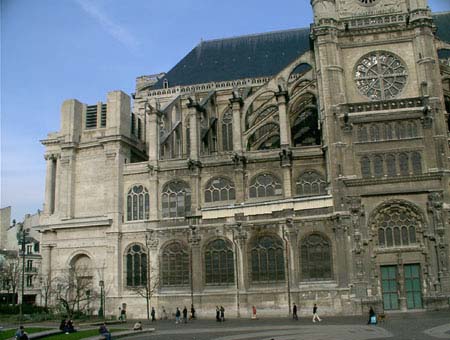
St. Eustache. The clunky Neo-Classical façade is on the left.
After we left the Samaritaine, we headed north past Rue de Rivoli to the cobblestone plaza in front of St. Eustache, a peculiar Gothic Cathedral with a single Neoclassical façade on the western side. I find it interesting that at the end of the 18th Century there was something of a backlash against Gothic architecture because it was considered "irrational" and "unenlightened." This backlash was such that Gothic elements were frequently plastered over and hidden behind "more rational" (though clunkier) Greek and Roman architectural elements. Happily, most of the world now realizes that no one architectural style is any more rational than any other. Still, from what Jessika has told me, the anti-Gothic/pro-Neo-Classical backlash continues in such places as Charlottesville, Virginia.
Between St. Eustache and the Pompidou Center further east is a decidedly commercial corridor with a distinctly American flavor. We'd seen such American brands as Häagen-Dazs, Coca Cola, and McDonalds in Paris (and in London we'd even seen -shudder- Starbucks), but here was the first time we'd seen a KFC. As greasy as it is, you'd think KFC would be fairly popular in France, though perhaps not as popular as Robespierre Fried Ham.
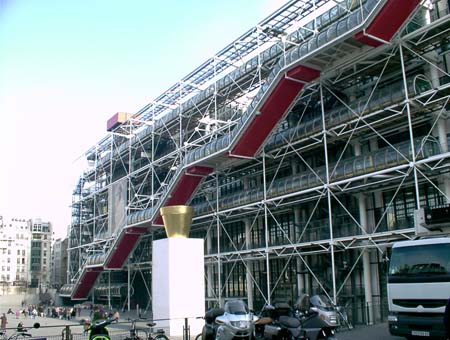
The Pompidou Center. Need a job? How about becoming a pipe cleaner? Click to enlarge.
We didn't actually go into the Pompidou Center, partly because that wasn't necessary. The architects had seen fit to display the guts of the building (which was all I cared to see) on the outside of the building. In all their maddening complexity, modern building services such as heating, plumbing, wiring, and air conditioning have some of the qualities of decorative and structural Gothic elements, especially when placed on the outside of a building. For the people charged with maintaining the Pompidou Center and Gothic Cathedrals, what with their tiny details and intricately folded surfaces, exposed as they are to the ravages of weather, the headaches and cursing of the designers are probably about the same.
In terms of cuisine, once we'd found a winner, it was hard for us to change course. So for lunch we stopped in a little Indian Restaurant called Sommets de l'Himalaya. As usual, we weren't disappointed in the food, though the complimentary table wine wasn't very good.
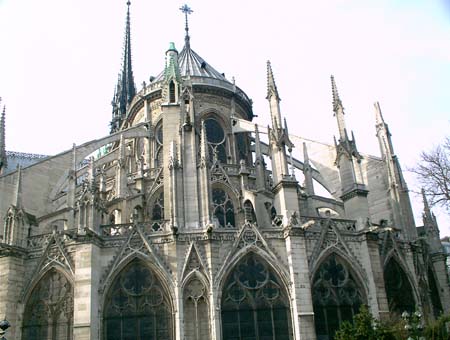
Notre Dame from the east. Click to enlarge.
Killing time before our airplane flight back to New York, we wandered around the north and east sides of Notre Dame, taking in all the gargoyles and flying buttresses we'd missed when we'd looked at it from the west. Beneath the east façade of Notre Dame were all kinds of details that had fallen or been removed from other parts of the building: gargoyles, treelike segments of stone snapped off from some peaked archway, and knobby bits of spire. As rich as it is in intricate stonework and maddening geometric complexity, the east and south sides of Notre Dame seemed to be the most in need of maintenance. Several of the gargoyles had rotted almost completely away, leaving grey metal gutters in their place. And some of the lesser spires appeared to have snapped off and fallen down, probably destroying other things along the way. Sand eroding from the stonework sat in piles on the top surfaces of anything that stuck outward and was particularly noticeable accumulated on the details of the rose window of the south façade.
Fast forward to our RER train ride to Charles de Gaulle Airport. Every time we passed through the neighborhoods north of Paris, I noticed a cluster of high-rise buildings capped with the brightly-lit logos of various prominent international corporations. At first I'd thought this was some sort of office park and these were Paris corporate headquarters. But the daylight had shown these buildings to be high-rise residences, and not especially appealing residences at that. They probably housed some of the many African immigrants we saw boarding at nearby RER stations. Evidently these logos were pure advertising, although they seemed rather ill-conceived in this particular city. One thing Gretchen and I had noticed about Paris was its visual serenity. Walls that in New York would be plastered with advertisements or glowing flat panel displays are, in Paris, allowed to just be walls. True, some of these are attacked by graffiti artists, and there are also a number of automatically-scrolling billboards on a few busy street corners, but much of the city is blissfully free of visual advertising. I thought perhaps this might be because the French, due to some aspect of their culture, don't respond well to visual advertising.
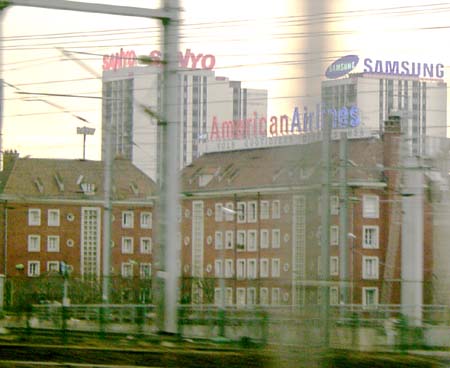
Advertising on high-rise apartments north of Paris.

Graffiti north of Paris.
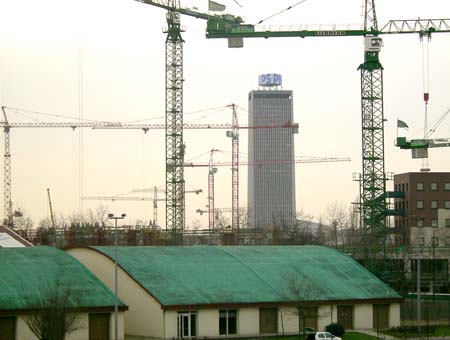
Cranes north of Paris.
Gretchen had paid the absolute least amount of money possible to get our RER tickets (they were enough to travel one or two RER stops, but not all the way to Charles de Gaulle Airport). The turnstile releasing us into the airport was programmed to refuse our tickets, forcing us to buy upgrades, but all we really had to do was jump the turnstile (as we've done several times before). In fact, as we jumped the turnstile in front of a group of National Police, they paid no attention to us. Apparently Gretchen's scam is standard procedure in Paris, because everyone else who had been on our train also jumped the turnstile. Jumping the RER turnstile at Charles de Gaulle Airport is such an accepted practice that the turnstiles are actually specially designed to allow easier jumping (otherwise, the people running the place would have to deal with more injuries).
As we were buying cheese and port in the airport duty-free store, off in the distance we could hear the horrendous screaming of some horrible little child. It sounded as if this poor child had been strapped down, had his belly slit open, and was having his intestines slowly drawn out of his body by an executioner dressed in a clown suit. In fact, of course, the child had simply been denied a lollypop or a Teletubbie® action figure. "He's probably on our airplane," groaned Gretchen.
We didn't face any serious security hurdles until we were actually boarding our airplane, a massive twin-engine Boeing 777. In front of us, every unaccompanied man was being ordered to take off his shoes and submit them to substantial probing by electronic wand. I joked to Gretchen that if there was any question about my shoes (which, as you may recall, have a void where the heel should be), I would gladly give them up. As I was walking up the ramp to the airplane, a security employee asked me "Parlez-vous français?" "No, I speak English," I said. He obviously wasn't listening to me, because he continued in French for awhile and then demanded, in English, that I open my bag. At that moment, his colleague, who'd been talking to Gretchen, told him to abandon his probing, that I was "with her." She'd told the guy that I was her husband and it conferred immediate non-terrorist legitimacy upon me.
When Gretchen discovered that our flight had been booked to capacity (375 people), she warned me that we were in for what was probably going to be a fairly miserable flight. It would be particularly miserable for her, since she had a middle seat in a three-seat cluster along the side, and, since she needs to pee a lot, she'd be disturbing the random guy to her right frequently.
On the flight back to New York, I took advantage of all the alcohol I could. When offered coffee, for example, I requested cognac, as did Gretchen, and when she couldn't drink hers, I did.
According to our real-time flight map, our path westward across the Atlantic was rather different from our path eastward. Coming east, we'd gone north through Newfoundland and then gone almost due eastward south of Ireland to Paris. Going west, we went north through England and Northern Ireland, continuing northeastward until the very southern tip of Greenland, where we gradually turned southward through Labrador and then due southward down the Hudson River to New York. I suspect we took this more northerly route to avoid the prevailing Westerlies and benefit from the Polar Easterlies.
The most spectacular view of the flight came when we passed over the St. Lawrence River northeast of Québec City. Through unclouded air I could sea the little electric-lit towns of both the northwest and southeast banks. They're more than 20 miles apart at that part of the river and from the ground one can't even see all the way across. In between, rippling water reflected light from a nearly-full waning moon.
The bratty little child we'd heard being drawn and quartered didn't start squalling until we began to descend from 39,000 feet and his precious little eardrums started going boo-boo. From then on he wouldn't shut up. I told Gretchen that I wanted to go to his parents and offer to donate a free spanking to their child-rearing cause.
At JFK Airport, we had to wait in two different lines before being loosed upon the land. The first was immigration, and we sailed through that. Then came customs and, well, it would be more interesting to say we ran into some sort of problem there, but we sailed through that too. "Where are you guys coming from?" the customs agent wanted to know, because he didn't know it was a flight from Paris.
I'd never seen such a mob of sign-holding people in an arrival area before, but we had to beat the mob and couldn't dawdle (or have fun impersonating highly-anticipated international überexecutives).
Out on the street, a gypsy cab tried to offer us a ride for $30, but Gretchen knew she'd get a better rate in a yellow cab, so we refused his offer and stood briefly in the taxi line. Gretchen was amazed how quickly our taxi whisked us home to Park Slope.
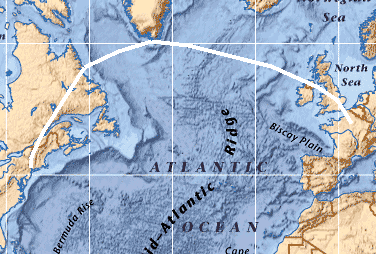
The way we flew westtward.
View a gallery of pictures from this adventure.
For linking purposes this article's URL is:
http://asecular.com/blog.php?020130 feedback
previous | next |






